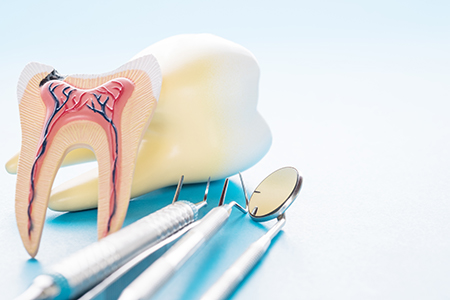
If you’ve been told a tooth may need a root canal, it’s understandable to feel uneasy. In modern dentistry, root canal therapy is a carefully controlled procedure designed to relieve pain, resolve infection, and preserve your natural tooth whenever possible. With up-to-date instruments and techniques, most patients find the experience manageable and the outcome reliable.
At the office of M. Kurt Berky, DDS, PC, we focus on clear communication and patient comfort throughout diagnosis and treatment. Our team combines clinical experience with current technology to create treatment plans that protect your oral health while minimizing discomfort and disruption to your daily life.
Root canal treatment allows a damaged or infected tooth to be saved rather than removed. Inside each tooth is the dental pulp — soft tissue that includes nerves and blood vessels. When that tissue becomes infected or irreversibly damaged, the resulting pain and potential spread of infection can put surrounding teeth and bone at risk. Removing the compromised pulp and sealing the canal preserves the tooth structure and maintains normal function.
Choosing to preserve a tooth with root canal therapy helps maintain proper bite alignment and prevents the bone loss that often follows extraction. Restoring the treated tooth with a crown or suitable restoration restores strength and helps it withstand everyday chewing forces. For many patients, this approach keeps their natural smile intact and avoids more complex replacement procedures.
Modern root canal techniques have a high success rate when performed with careful diagnosis and thorough follow-up restoration. Treatment priorities include eliminating infection, disinfecting the internal tooth anatomy, and sealing the canals to prevent reinfection. When these steps are followed, the treated tooth can remain healthy and functional for many years.

Not every toothache means a root canal is required, but certain patterns and symptoms warrant prompt evaluation. Persistent or worsening pain, especially pain that wakes you at night or lingers after hot or cold exposure, often indicates irritation deep inside the tooth. Sensitivity that increases rather than resolves is another signal that the inner tissues may be compromised.
Other reasons to seek assessment include new or increasing swelling near a tooth, darkening or discoloration of a single tooth, or discomfort when biting and chewing. Teeth that have been fractured, chipped, or injured in an accident can develop pulp damage even if the outer appearance seems intact. In some cases, a tooth shows no symptoms yet reveals abnormalities on X-rays that indicate the need for treatment.
A thorough clinical exam and appropriate imaging help determine whether the pulp can be saved or if extraction is necessary. Early detection improves the chance of a predictable outcome; when in doubt, scheduling an evaluation allows your clinician to outline options, explain potential risks, and recommend the most conservative and effective path forward.

Delaying care for a tooth with a damaged or infected pulp can allow problems to spread. An untreated infection may advance to involve surrounding bone and adjacent teeth, increasing the complexity of treatment and the risk of complications. Prompt root canal therapy typically halts the progression of infection and reduces the likelihood of more extensive procedures later on.
Addressing pulpal disease early also preserves more of the natural tooth structure, which supports stronger and longer-lasting restorations. When infection progresses, more tooth structure can be lost to decay, fracture, or surgical intervention. Timely care keeps restorative options broader and more conservative.
Beyond structural concerns, unresolved dental infections can cause ongoing discomfort and interfere with daily activities. In some situations, dental infections may affect systemic well-being. For these reasons, clinicians emphasize evaluation and treatment soon after symptoms appear or radiographic changes are discovered.
Root canal therapy typically begins with a careful exam and appropriate imaging. Once the tooth is anesthetized, a small access opening is made to reach the pulp chamber and canal system. Diseased tissue is gently removed, and canals are cleaned and shaped with precision instruments to remove bacteria and debris while preserving healthy tooth structure.
After disinfection, canals are filled with a biocompatible material and sealed to protect the interior from future contamination. Some cases are completed in a single visit; others require multiple appointments when there is significant infection or when careful layering of treatment is needed. Local anesthesia is routinely used, and additional comfort measures are available for patients who experience anxiety.
Following canal treatment, the tooth usually receives a protective restoration, often a crown, to restore full strength and function. Proper restoration is an essential step: it prevents fractures and provides a long-term seal. Your dentist will discuss the recommended restorative timeline and options to ensure the best functional and esthetic outcome.

After treatment, it’s normal to experience some sensitivity or mild soreness as surrounding tissues heal. This discomfort typically subsides over a few days and can be managed with over-the-counter medications as directed. Until sensation returns fully, take care to avoid accidentally biting the cheek or tongue and follow any specific post-operative instructions provided by your clinician.
Antibiotics may be prescribed in cases with significant infection; if so, it’s important to complete the prescribed course. Treating the tooth with a definitive restoration in a timely manner is also crucial because a tooth that has undergone root canal therapy is more prone to fracture without protective coverage. Avoid hard or sticky foods on the treated tooth until your permanent restoration is placed.
With good oral hygiene—brushing twice a day, flossing daily, and attending regular dental exams and cleanings—a root canal–treated tooth can function well for many years, even a lifetime. If you notice new or worsening symptoms after treatment, contact the office promptly so a clinician can assess healing and address any concerns.
We strive to make root canal care as predictable and comfortable as possible. If you have questions about symptoms you’re experiencing, the steps involved in treatment, or the recommended restoration for a treated tooth, the team at M. Kurt Berky, DDS, PC is available to help. Contact us for more information or to schedule an evaluation.

A root canal procedure is the best way to save a tooth that has been damaged by decay or injury and preserve your natural smile. The alternative is an extraction and treatment to replace the tooth. While at times a tooth is non-restorable and an extraction is the only option, when possible, it’s best to try and save your natural tooth. With proper care, a tooth with root canal therapy can serve your smile well for many years to come.
Despite lingering myths from before the age of modern dental anesthesia and technology, having a root canal procedure today is as routine and comfortable as visiting the dentist for a filling. While the procedure is performed under local anesthesia with your tooth completely numbed, we can also discuss options in dental sedation.
Whether the symptoms of a dental infection subside after a course of antibiotics, a draining abscess provides you with some temporary pain relief, or a tooth with radiographic evidence of pathology has not yet developed symptoms, it’s essential, before an infection worsens or occurs, to have a root canal procedure performed. In this way, the tooth can be disinfected, filled, and sealed to protect your health and avoid further problems.
If you have sustained a dental injury, have a toothache, jaw pain, swelling, or are experiencing any other unusual and uncomfortable oral symptoms, contact our office immediately for care. Dental problems that have not been evaluated and treated can significantly worsen, producing more severe damage and consequences for the involved teeth, your oral health, and even your overall wellbeing. Once you get in touch with our office, our friendly and compassionate office team will get you in for care at your earliest convenience.
While some root canal procedures can be completed in one visit, others may involve 2 or 3 appointments. How long it takes depends on various factors, including active infection, the number of canals in the tooth, and the tooth’s location or anatomy.
With a success rate that exceeds 95%, root canal therapy remains the most effective procedure to save a tooth in which the inner vital tissues have been damaged. However, as with all healthcare procedures, there are a small percentage of cases where the teeth become symptomatic a second time. The good news is that many of these teeth can still be saved with root canal retreatment or a minor surgical procedure known as an apicoectomy.
The best ways to maintain a tooth with root canal therapy are to get the proper restoration required to rebuild and protect the tooth, maintain proper oral hygiene, and schedule appointments for routine dental checkups and care.
Saving a tooth with root canal therapy is a wise investment that, in the long run, is typically less costly and invasive than having the tooth extracted and replaced with a fixed bridge or implant. As far as the exact cost of care, it can vary depending on which tooth is being treated. Many dental insurance plans provide coverage for root canal therapy. At the office of M. Kurt Berky, DDS, PC, we do our best to optimize your dental benefits and minimize your out-of-pocket expenses. Our staff will answer all your questions about the cost of care and discuss all your payment options.
At the office of M. Kurt Berky, DDS, PC, we use the latest technology and most effective methods of care to provide precise and gentle care. Our reputation for excellence is based upon a consistent record of achieving successful treatment outcomes while providing prompt, stress-free, and convenient treatment for every type of dental need.
A root canal is a dental procedure that removes diseased or damaged tissue from inside a tooth to relieve pain and stop infection. The treatment targets the dental pulp, which contains nerves, connective tissue and blood vessels that can become inflamed or infected from decay or trauma. By cleaning and sealing the internal structures, a root canal preserves the natural tooth and restores its function.
The primary goals of root canal therapy are to eliminate infection, prevent its spread to surrounding tissues, and maintain the structural integrity of the tooth. When successful, the procedure allows patients to keep their natural tooth rather than opting for extraction and replacement. Modern techniques and materials contribute to high long-term success rates for treated teeth.
Common warning signs include persistent or severe tooth pain, heightened sensitivity to hot or cold, pain when biting, and swelling of the gums near the affected tooth. A tooth that has darkened or shows visible cracks or chips can also indicate internal damage or a devitalized pulp. These symptoms suggest the nerve or supporting tissues are compromised and warrant prompt evaluation.
Not every tooth that needs a root canal produces obvious symptoms; some teeth are identified during routine exams or on radiographs showing root end pathology. Because infections can progress without intense pain, it is important to report changes in sensation or appearance to your dentist early. Timely assessment allows for less invasive treatment and better outcomes.
A root canal typically begins with administration of local anesthesia to ensure the area is numb and the patient is comfortable during the procedure. The dentist then isolates the tooth, creates a small access opening, and removes the diseased pulp tissue before cleaning and shaping the internal canal system. After thorough disinfection, the canals are filled with a biocompatible material and the access cavity is sealed with a temporary or permanent filling.
Some treatments can be completed in a single visit, while others require two or more appointments depending on anatomy and the presence of infection. When indicated, additional comfort measures such as dental sedation are available to help patients relax. A permanent restoration, often a crown, is usually recommended afterward to protect the tooth and restore full chewing function.
Thanks to modern anesthesia and technique, most patients report little or no pain during a root canal procedure itself, and many describe the experience as similar to receiving a routine filling. The objective of the treatment is to remove the source of acute toothache, and most patients notice significant relief once the infection is addressed. Your clinician will ensure the area is numb and will discuss comfort options before beginning.
After the procedure, it is normal to experience mild to moderate soreness for a few days as surrounding tissues heal, and this is usually manageable with over-the-counter pain relievers unless a prescription is indicated. Following post-operative instructions, avoiding heavy chewing on the treated tooth, and returning for the recommended restoration will reduce complications. If severe or worsening pain occurs, contact your dentist promptly for evaluation.
Immediately after treatment you may have lingering numbness for an hour or two while the local anesthetic wears off, and it is important to avoid chewing on the treated side during that time. Mild tenderness and sensitivity around the tooth and gum tissues are common for a few days as inflammation subsides, and symptoms typically improve steadily during that period. If a temporary filling is placed, patients should be cautious with hard or sticky foods until a permanent restoration is completed.
Full recovery varies by individual and by the complexity of the infection, but most people resume normal activities the same day or within a day or two. If antibiotics or additional medications were prescribed, complete the course exactly as directed and follow any follow-up instructions from your dentist. Persistent or increasing symptoms after several days should prompt a return visit for re-evaluation.
After root canal therapy it is important to maintain good oral hygiene with gentle brushing and daily flossing to support healing and prevent new decay around the treated tooth. Because a tooth that has had a root canal can be more brittle, avoid chewing hard objects or very chewy foods on that side until a permanent crown or restoration is placed. Your dentist will recommend a timeline for the final restoration and may place a temporary filling in the meantime to seal the tooth.
If you experience unusual symptoms such as severe pain, swelling, or drainage, contact the office of M. Kurt Berky, DDS, PC for prompt evaluation and care. Timely placement of a permanent crown or appropriate restoration is essential to restore strength and long-term function. Regular dental checkups and radiographs will help monitor the treated tooth over time.
With proper restoration and routine oral care, a tooth treated with root canal therapy can last many years and often remains functional for a lifetime. The long-term prognosis improves when the tooth is promptly restored with a durable crown or other suitable restoration that protects remaining tooth structure from fracture. Regular dental examinations and good hygiene are key elements in preserving treated teeth.
Success rates for modern endodontic treatment are high when procedures are performed with careful technique and appropriate follow-up care, although individual outcomes depend on factors such as the tooth's anatomy, the extent of preexisting infection, and overall oral health. If problems develop later, retreatment or surgical options are available and can often save the tooth when indicated.
The primary alternative to root canal therapy is extraction of the affected tooth, after which tooth replacement options such as dental implants, bridges or partial dentures can be considered to restore function and appearance. Extraction may be indicated when a tooth is fractured beyond repair, when there is insufficient supporting bone, or when the patient chooses not to pursue endodontic treatment. Each replacement option has advantages and clinical considerations that your dentist can explain.
Root canal therapy is generally recommended when a tooth can be saved because preserving a natural tooth helps maintain jawbone and adjacent tooth stability. Decisions about treatment should be based on a comprehensive exam, imaging, and a discussion of long-term oral health goals with your dental provider. A consultation will clarify whether conservative therapy or extraction and replacement best meets your needs.
Although root canal therapy is highly successful, complications can include persistent infection, continued pain, or re-infection of the canal system, especially in teeth with complex anatomy or extensive damage. When symptoms persist, retreatment of the canals or a surgical procedure such as an apicoectomy may be recommended to address unresolved pathology. Your dentist will evaluate symptoms, radiographs and clinical findings to determine the appropriate next steps.
Early recognition of complications improves the likelihood of a favorable outcome, so report increasing pain, swelling, drainage, or changes in bite as soon as they occur. In many cases, additional treatment can resolve problems and preserve the tooth; in others, extraction and replacement may be necessary. Follow-up care and monitoring are integral parts of successful endodontic management.
Choosing a provider for root canal therapy involves considering clinical experience, training, and the technology available to support predictable outcomes, such as digital radiography and modern instrumentation. Discuss your case with the treating dentist to understand their approach, expected sequence of care, and recommendations for the final restoration that will protect the treated tooth. If your situation is complex, your dentist may refer you to an endodontist who specializes in root canal treatment.
At M. Kurt Berky, DDS, PC, patients can expect care that combines experience with contemporary techniques to achieve comfortable, effective treatment tailored to individual needs. A clear treatment plan and open communication about follow-up steps help ensure the best possible result for each patient. If you have questions or concerns about root canal therapy, schedule a consultation to review options and next steps.

Have questions or need to book your next appointment?
Our friendly staff at M. Kurt Berky, DDS, PC is ready to assist. Whether by phone or our online contact form, contacting us is simple and convenient. Start your journey to a healthier, brighter smile today by reaching out to our office.